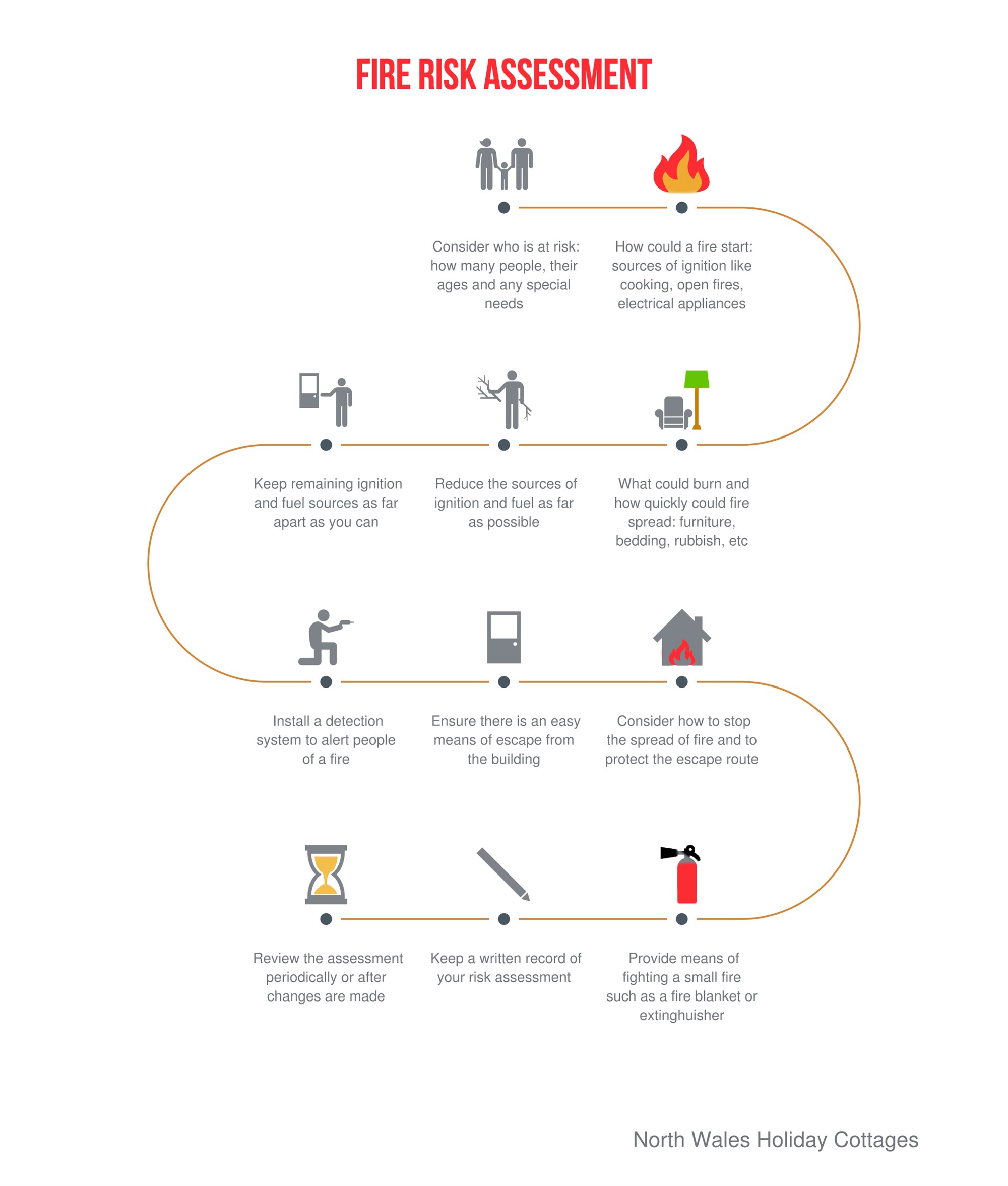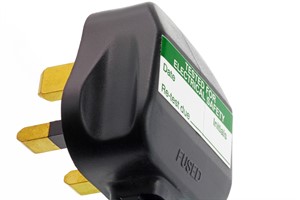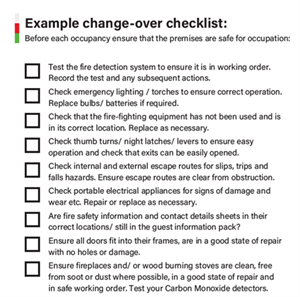Posted on 04/10/2023 by David
There are around 40,000 domestic fires in the UK each year. As owners of holiday lets you have an obligation to make sure your property is safe for guests staying there. Conducting a fire risk assessment is a legal requirement and provides you with a plan for keeping your house and your guests safe.
Fire risk assessments must, by law, be documented (i.e. written down). This guide gives an overview and suggests things to consider which we hope you will find useful. Probably, the best option as a business owner would be to pay for a professional fire risk assessment, though this is not a requirement. For properties which are classed as complex (sleeping more than 10 people, have 3 or more floors, or have an escape route from a bedroom which leads through another room, including an open living area), you would need an advanced level of knowledge to understand how a fire may develop and spread to competently assess the risks involved. As a result, you will almost certainly need a professional fire risk assessor to undertake this task for you.
How do you conduct a fire risk assessment?
The risk assessment identifies possible ways a fire may start in your house, how it could spread, how people can be alerted to fires and how they will escape from the building. Once risks and possible issues have been identified you can then take steps to eliminate or reduce these risks. Below is an infographic giving an overview of the process:

Who is at risk?
Consider the types of people who may be staying at your property, the number, their ages or any particular disabilities they may have. Also consider anyone else who may visit the property such as cleaners or builders. Could their activities create any risks or would some people have difficulty getting out of the building in an emergency? Remember to take this into account in each of the steps below.
Please note, it is not acceptable to state that your property is unsuitable for disabled people and think this means you do not have to take this into account. Disability includes deafness, visual impairment, learning difficulties, mobility issues and other impairments. Discrimination law requires reasonable steps are taken to make your property accessible, the reality is there may not be any reasonable extra measures you can take but you must consider this.
Sources of ignition
Fires always have a source of ignition. The most common place for a fire to start is the kitchen with 50% of accidental domestic fires ignited by cooking appliances. Faulty electrical equipment and leads is the second most common source. It is a legal requirement to have an electrical installation condition report (EICR) which checks the condition and set up of the wiring in the property to make sure it's safe. An EICR will last for 5 years unless any electrical work is done during this time.
Sources of fuel
What could burn in your property? The most common thing to catch fire is food stuffs including grease and oil (the kitchen again) with 27% of all incidents starting this way closely followed by textiles, upholstery and furnishings at 26%. Ensure your furniture complies with fire regulations, this means they will meet standards of how easily they catch fire, how quickly they burn and the smoke they produce. Furniture bought in the UK since 1990 should comply with these rules.
Reduce sources of ignition and fuel
What did you identify in the previous steps and how could you reasonably remove or reduce these? Examples include checking electrical appliances to make sure they are safe and undamaged, best practice would be for all items to be PAT tested. Don’t overload electrical sockets. In Wales, Smoking is not permitted in Furnished Holiday lets.

For fuel sources you could make sure you keep the kitchen clean from a build-up of grease, replace or clean the extractor fan filters as required, empty crumbs from the toaster and ensure the tumble drier filters are cleared. Don’t store rubbish which could catch fire (including outside the property which may invite arson).
Separate Sources of ignition and fuel
After looking at all the ways you can reduce sources of ignition and fuel there will always be some items that you can’t reasonably remove such as cookers or heaters and soft furnishings. In these cases, make sure they are kept apart. For example, make sure towels and dish clothes are stored away from the toaster, oven and other heat sources. If you have an open fire, you should provide a fire guard to prevent sparks escaping and have the chimney swept at least once a year. If you have candles, make sure they are contained in holders with sides higher than the maximum flame height.
Detection Systems
If there is a fire how will people be alerted to it? As a minimum, you will need a Grade D1, LD1 fire alarm system under BS5839 Part 6 installed at your property. This means, smoke or heat detectors in every room of the house except the bathrooms. These are mains powered with a battery backup and interlinked, so if one detector is triggered all the detectors will sound an alarm. Heat detectors are used in locations where it may not be appropriate to have a smoke detector such as the kitchen or in a garage. Combined heat and smoke detectors provide extra protection and may help mitigate the risk in problem areas like open plan living spaces. We recommend having the system professionally installed.
Why hard wired and in every room? Figures for Wales in 2015-16 show that 13% of smoke detectors which failed to operate was due to defective or missing batteries. The most common reason for smoke detectors failing to operate when there is a fire is because the smoke did not reach them (55% of cases in Wales).
Make sure the smoke detectors are checked regularly, you could make it part of the cleaning process before each booking. Keep detectors free of dust which helps prevent false alarms.
It could be that your property requires a more complex “panel” type system, particularly if it is a large house. Seek professional advice if you are unsure.
Escape Routes
Once a fire is detected and the occupants alerted, how will they escape from the house? Make sure there is a clear path to the exits and it is protected from fire and smoke. Remember that people identified in the first step (who is at risk?) may not be familiar with the layout of the house, will they need emergency lighting if this happens during the night? Supplying a clearly identifiable torch may be enough or you may find that street lighting outside the house is sufficient to light the way. If there are several bedrooms and the route is quite long then it may be more appropriate to install automatic emergency lighting. Will visitors remember where they left the keys to unlock the door, particularly for large houses which sleep lots of people? The law is quite clear, guests must be able to exit the building without the need for a key. For UPVC or composite doors, you may need to install thumb turns or single-action handles if you don’t already have them. On a traditional door, a night latch is acceptable.

The sources of ignition and fuel you identified above will suggest areas of the house with a higher fire risk (such as the kitchen). Is there an escape route which avoids this area? Escape routes need to be appropriately protected from fire and smoke so guests have time to get out of the building in the event of a fire. In most cases a well fitted solid door will suffice but hollow core, thin panel, and any plain (non-fire resisting) glazing within doors or frames, provide little fire resistance and will normally need to be replaced.
Evacuation Plan
You must have a clear evacuation plan written down and available to the guests, informing them what actions to take in the event of a fire. An accompanying floor plan indicating the exit route/s would be useful in many cases, particularly in larger properties and properties with a layout which may necessitate using different exits depending on where you are in the property.
This could include instructions on the back of the bedroom door and information in a welcome pack or information folder.
Provide fire escape information in your property information folder as well as contact number for emergencies, remember that your guests may not be from this country.
Fire Fighting Equipment
You must have a fire blanket and/or appropriate fire extinguishers (not the powder type). These should be conveniently located and easily available for use (not in a cupboard under the sink). All such equipment should be inspected regularly, serviced as required and withdrawn when past its expiry date.
Record Keeping
Make sure you keep a written record of all risk assessments and the date they were completed. You can then review these assessments on an annual basis or whenever any changes are made to the property. It’s also proof that you have undertaken the task.
Fire Safety Checks at Changeovers
 A simple maintenance and testing checklist can be used to make sure items and equipment are checked and tested in accordance with current best practice guidance. The Joint Welsh Fire Services have created this checklist which you can use.
A simple maintenance and testing checklist can be used to make sure items and equipment are checked and tested in accordance with current best practice guidance. The Joint Welsh Fire Services have created this checklist which you can use.
Further information:
https://www.gov.wales/make-your-guest-accommodation-safe-fire The latest Welsh Government guidance for guest accommodation made up of single premises such as houses, cottages, and chalets consisting of a ground floor, or ground and first floor, providing sleeping accommodation for a maximum of 10 persons (including infants and anyone sleeping on a sofa bed or similar), with no more than four bedrooms on the first floor. This guidance also covers individual flats (whether within a purpose-built block of flats or a house that has been converted into flats).
https://assets.publishing.service.gov.uk/government/uploads/system/uploads/attachment_data/file/422192/9281_Sleeping_Accomodation_v2.pdf The existing guidance for properties which fall outside the scope of the above guide. i.e. larger properties, properties with open-plan living areas through which guests must pass to evacuate. (Note: If your property falls into the category requiring you to follow this guidance you would be better off having a professional fire risk assessment carried out by a competent person and using this document as a reference point on what to expect).
https://www.firesectorfederation.co.uk/fire-risk-assessment/ Choosing a fire risk assessor.
https://historicengland.org.uk/images-books/publications/fire-resistance-historic-timber-panel-doors/ A guide to the fire resistance of historic timber panel doors.
North Wales Fire and Recue Service website
Statistics come from
Fire Statistics England 2014/15: https://www.gov.uk/government/uploads/system/uploads/attachment_data/file/532364/fire-statistics-england-1415-hosb0816.pdf
Stats Wales:https://statswales.gov.wales/Catalogue/Community-Safety-and-Social-Inclusion/Community-Safety/Fire-Incidents

